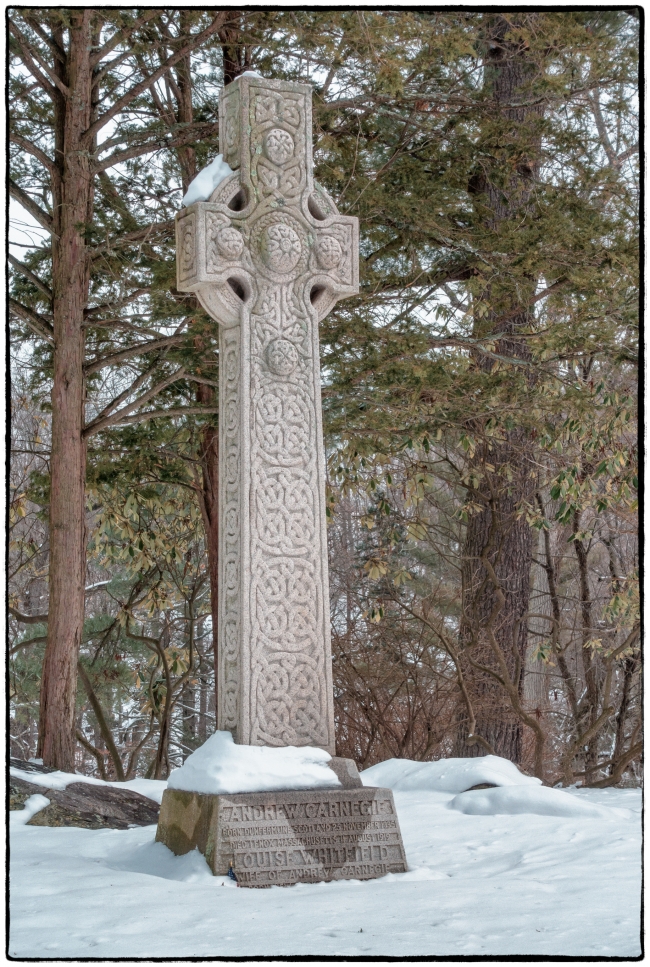In contrast to the magnificent mausoleums of William Rockefeller and John Dustin Archbold (In the two previous posts), the simple celtic cross in the picture above marks the final resting place of Andrew Carnegie. He was for a while the richest person in America (and so probably in the World).
According to Waymarking.com:
The grave is set in a grass clearing surrounded by trees. The monument itself is an ornately carved stone cross, about six feet tall. The cross has round knobs at the center and in each direction of the cross. There is a halo connecting the cross extensions. At the bottom is the following text:
“Andrew Carnegie
Born Dunfermune (NOTE: it actually reads ‘Dunfermline’ not ‘Dunfermune’) Scotland 25 November 1835
Died Lenox Massachusetts 11 August 1919Louise Whitfield
Wife of Andrew Carnegie
Born New York 7 March 1857
Died New York 24 June 1946”Two simple footstones are at the base of the cross, one for Andrew and the other for Louise.
A plaque in a stone by the road has a 3-D portrait embossing of Andrew Carnegie’s face and the following text:
“Born in Scotland, Andrew Carnegie came to America in 1848 and rose from a factory bobbin boy to one of the world’s most successful industrialists. His legacy is his philanthropy and the more than 2o institutions he endowed. Their work continues in his name:
Carnegie Hall
Carnegie Institute
Carnegie Mellon University
The Carnegie Trust for the Universities of Scotland
Carnegie Institute of Washington
Carnegie Foundation
The Carnegie Dufermline Trust
Carnegie Hero Fund Commission
Carnegie Hero Funds in Europe
The Carnegie Foundation for the Advancement of Teaching
Carnegie Endowment for International Peace
Carnegie Corporation of New York
The Carnegie United Kingdom Trust
Carnegie Council on Ethics and International Affairs”There are many biographies on Andrew Carnegie. He is one of the most studied men in the United States. The links included provide a more detailed account. Here are highlights:
He was born in Scotland to William Carnegie, a shoemaker and social reformer, and Margaret. When they emigrated to America and settled in Allegheny, PA, at the age of 13, Andrew started working as a bobbin boy (a child who changed thread bobbins on the fly on the textile looms). As a child, he read books, often from a library that a local resident had opened to working boys. Later, Andrew would work on the Pennsylvania Railroad. While working there, he started the Keystone Bridge in 1873, the first of his steel works. By the time he sold his company to J.P. Morgan, it was worth $480 million (about $13 billion today). Starting around 1870, Carnegie donated money for communities, mostly libraries across the U.S. He founded other institutions that continue to benefit people and communities today (many listed above). He is also known for his publication, “The Gospel of Wealth,” where he pushed forward the idea that the rich are only caretakers of wealth and are obligated to return it back to benefit the general public. He died in 1919.
There were controversial events associated with Carnegie. The most well known is the Homestead Strike of 1892, which involved a union strike at one of his steel works that became bloody.
I saw neither the two footstones, nor the plaque mentioned above, probably because they were covered by the 10 inches of snow that blanketed the site. The snow nearest the road was particularly deep (I know because I waded through it) as a result of ploughing and would certainly have covered the plaque).
More details can be found in a Wikipedia article on Carnegie.

